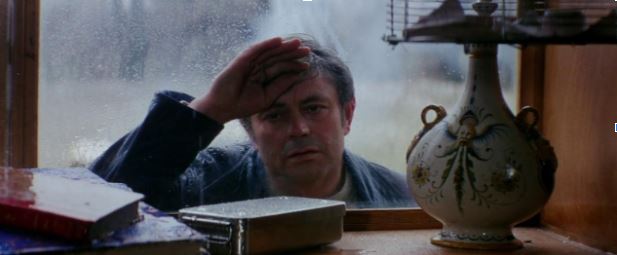Three Foreign Films that Explore Loneliness
April 22, 2020
Connection, or perhaps the frequent inability to establish connection, is a common thread in cinema. The theme is vast and covers various epochs of film history. In an attempt to trim down this intimidatingly, ubiquitous topic the selection has been narrowed down to three films; “Ikiru” by Akira Kurosawa, “Loving Vincent” by Dorota Kobiela and Hugh Welchman and “Solaris” by Andrei Tarkovsky. Films which confront or dissect different facets of sustained loneliness and what it means to be comforted by another.
“Art can always be an escape so when creating a piece loneliness might be the reason you cling to color and shape,” Bella Haidet, artist and amateur filmmaker, said. “Art doesn’t discriminate. Art is open and allows people the space to let go of invalidation or invulnerability.” Existing within an emotional and psychological space that is distinct and different from solitude or seclusion.
“End of life loneliness is a common conflict,” Haidet said. “Not wanting to die alone but also wanting peace with oneself … ‘How many girls did I fuck?’ ‘How much money did I make?’… It’s all trivial when the basis of all you wanted was connection.”
Kurosawa, famed Japanese director, shared similar sentiments when explaining the origins of his film 1952 “Ikiru” within the in-depth analysis “A Study of Kurosawa’s Ikiru, Part 1” by Aryeh Kaufman. The phrase ikiru meaning “to live.”
“Sometimes I think of my death. I think of ceasing to be,” Kurosawa wrote. “It is from these thoughts that “Ikiru” came.”
The film, which follows the last six months of dying Tokyo bureaucrat, Kanji Wantanabe, attempts to explain the end-of-life isolation that is often the culmination of lifelong choices. Isolation from family through work, failure of romance due to external factors and the ability to enjoy simple tasks are all explored by Kurosawa in tenderly, intimate scenes that give the film hues of hopefulness despite its somber subject matter.
“The film often depicts Wantanabe, played by Takashi Shimura, in an office environment that emphasizes his physical and emotional absence,” Kurosawa wrote. “Wantanbe’s death sentence, an advanced stomach cancer, shocks the protagonist and leads to his despair. After disavowing his prior existence he begins searching for the means to live life to the fullest.”
The film also utilizes an unconventional, non-sequential structure that allows the viewer to comprehend Wantanbe’s loneliness via external and internal vantage points. Linking the gulf between the effects of loneliness on the self and upon those nearby.
This dual perception carries over in the Polish made production “Loving Vincent.” A film that focuses on the life of Vincent van Gogh and those who loved him during his lifetime. The film boasts the unusual accomplishment of having 62,450 oil paintings, created by 125 artists over the course of a decade, said movie critic Charline Jao, used for frames within the film. Art in motion.
“The artwork is mesmerizing, as if we are watching a painting organically move and take on a life of its own,” Jao wrote in her review. “The frame often lingers on van Gogh’s original composition before going into motion, which feels like an excellent and appropriate tribute to his work.”
Van Gogh, a figure too often romanticized for his mental illness and prodigious sadness, is given a revived sense of humanity. Van Gogh is painted, quite literally, as the lonely, odd man he was.
[”Loving Vincent”] provides a small glimpse into the mind of this genius man. It likely says more about him than the film, that the movie couldn’t fully contain his capacity for love, loneliness, and imagination,” Jao wrote.
This capacity for loneliness and love is matched ratherly brilliantly by the haunted characters presented in Russian filmmaker Tarkovsky’s introspective sci-fi classic “Solaris.”
Phillip Lopate, Criterion Collection film critic and essayist, describes the picture as “anti-2001.”
“Tarkovsky had seen Kubrick’s “2001: A Space Odyssey” (1968) and disliked it as cold and sterile,” Lopate wrote in his essay “Solaris: Inner Space.” “”Solaris” is saturated with grief, which grips the film even before it leaves Earth. In the moody prelude, we see the protagonist, a space psychologist named Kris Kelvin, staring at underwater reeds as though they were a drowned woman’s tresses. Played by the stolid Donatas Banionis, a Russian Glenn Ford with a five o’clock shadow and a shock of prematurely white hair, Kris looks forever traumatized, slowed by some unspeakable sorrow.”
That sense of sorrow and emotional seclusion is confounded by Tarkovsky’s long take filming style, said amateur filmmaker Ethan Mizzi.
“Tarkovsky saw, like let’s say, a two-mintute still shot of a potted plant as visual poetry,” Mizzi said. “That shot is in harmony with things he has presented emotionally or visually.”
The living planet of Solaris renders ghosts or “visitors” from the crew’s sleeping memories, forcing unresolved mistakes and unquenchable trauma to be confronted. While also proposing interesting questions about the nature of space exploration itself. Whether it is conducted out of a genuine desire to make “contact” or if it is an extension of the familiar. A reduction of the unknowable into the human.






